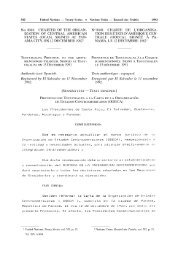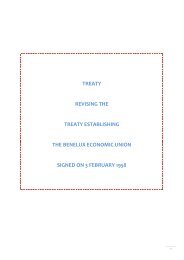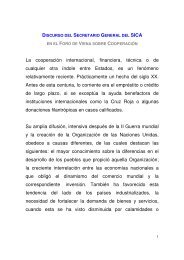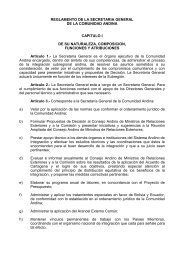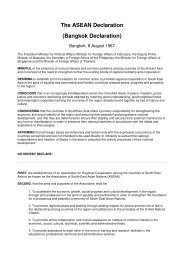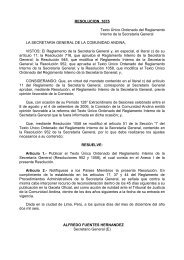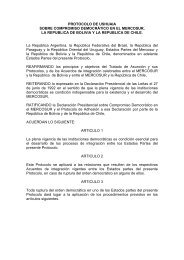Central American Integration System â Ioannis Papageorgiou
Central American Integration System â Ioannis Papageorgiou
Central American Integration System â Ioannis Papageorgiou
Create successful ePaper yourself
Turn your PDF publications into a flip-book with our unique Google optimized e-Paper software.
<strong>Central</strong> <strong>American</strong> <strong>Integration</strong> <strong>System</strong> – <strong>Ioannis</strong> <strong>Papageorgiou</strong><br />
instance, the various transformations of what is called now the Andean Community of<br />
Nations).<br />
The direct election of the members of the <strong>Central</strong> <strong>American</strong> Parliament did not<br />
only directly introduced citizens in the integration process, but it also expanded the<br />
integration objectives into the political sphere, by linking regional integration to<br />
democratisation and peace. Indeed, it is interesting to recall the similarities with the<br />
foundation and the subsequent enlargement of the European Communities: it was to<br />
avoid another war and to consolidate democracy in Germany that Europeans built<br />
their first supranational structures; and it was to avoid the return of dictatorial regimes<br />
that the Southern European states (Greece, Spain and Portugal) joined the EC later.<br />
The same objective – as well as economic and geopolitical considerations – was also<br />
evident in the 2004-7 enlargements of the E.U. to <strong>Central</strong> and Eastern European<br />
countries: economic arguments are accompanied by the conviction that joining a larger<br />
European family would strengthen democratic institutions.<br />
Several reasons led to this change of paradigm. In 1986, for the first time since<br />
1954, a civilian, Vinicio Cerezo, was elected President of Guatemala. Cerezo was a<br />
Christian-democrat; he belonged to the moderate and reformist tradition of <strong>Central</strong><br />
<strong>American</strong>s who wanted to promote democratic and social changes through peaceful<br />
means and for whom the regional framework was as natural as the national one. At the<br />
same time, the military deadlock had made clear that regional conflicts could not be<br />
solved only by military means. Also, for the first time the European Community<br />
became actively involved in <strong>Central</strong> America, which was, till then, considered as the US<br />
“backyard”: the EC saw the region from a different angle that the US and tried to<br />
promote projects aiming more in confidence-building and less in confrontation. Finally,<br />
the fear that Costa Rica might be dragged into the regional wars convinced President<br />
Oscar Arias Sanchez – also newly elected – to give up the traditional neutrality and<br />
detachment of his country from events in its region and to propose a plan for<br />
democratisation that included also regional integration elements.<br />
The responsibility to prepare the text for the treaty that would establish the<br />
Pariament was assigned to a committee composed by the Vice-Presidents of the five<br />
states, under the chair of the Guatemalan Vice-President, Roberto Carpio Nicolle. The<br />
7





